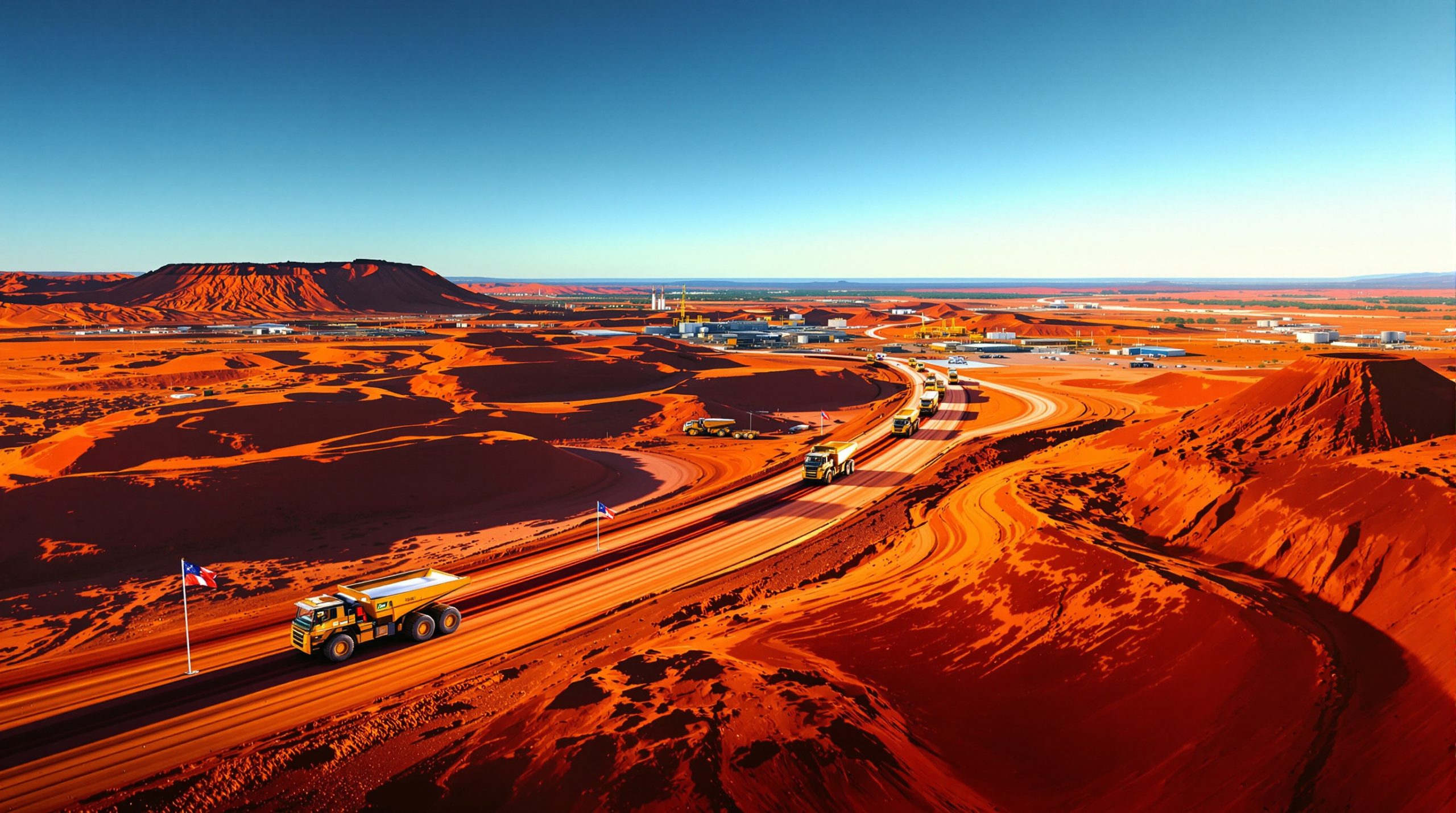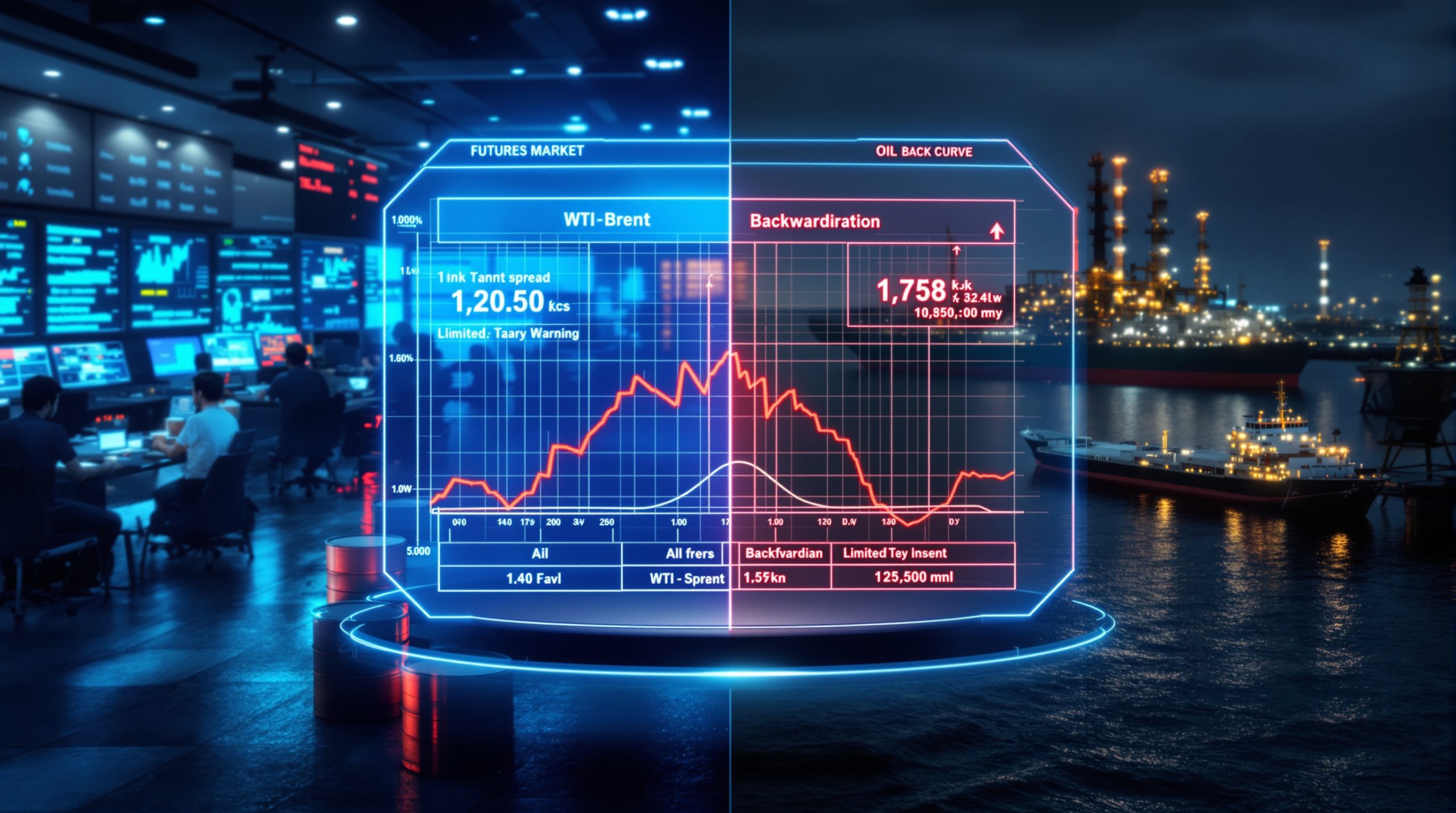Rio Tinto's $733M Pilbara Iron Ore Investment: Strategic Expansion Analysis
Rio Tinto, alongside joint venture partners Mitsui Iron Ore and Nippon Steel, has announced a significant $733 million investment to develop new iron ore deposits at the West Angelas hub in Western Australia's Pilbara region. This strategic move represents a commitment to sustaining production capacity in one of the world's most important iron ore regions rather than expanding it.
Project Scope and Investment Breakdown
The total investment of $733 million includes Rio Tinto's share of $389 million, with the remainder coming from joint venture partners Mitsui Iron Ore and Nippon Steel. The project aims to maintain the West Angelas hub's annual production capacity at 35 million tonnes, with first ore expected by 2027.
The development is characterized as a sustaining project, focused on extending existing operations rather than creating new mining infrastructure. This approach maximizes the use of current facilities while developing new deposits within the operational footprint.
Employment and Economic Impact
The West Angelas Sustaining project will generate approximately 600 construction jobs during the development phase. Once operational, it will support around 950 full-time positions, providing significant employment opportunities in the region.
Beyond direct employment, the project will deliver substantial economic benefits to Western Australia's mining sector through supply chain engagement, supporting local businesses and service providers throughout the project lifecycle.
Why is Rio Tinto Investing in Pilbara Iron Ore?
The West Angelas Sustaining project reflects Rio Tinto's strategic focus on maintaining rather than expanding production capacity. This approach highlights the company's commitment to sustainable, long-term operations in the Pilbara region by extending the life of existing assets rather than developing completely new operations.
Strategic Importance of Production Maintenance
Maintaining production capacity at 35 million tonnes annually is crucial for Rio Tinto's continued presence in the global iron ore market. This strategy allows the company to optimize its existing infrastructure investments while ensuring a steady supply of high-quality ore to key markets.
The approach minimizes capital expenditure compared to greenfield development while maximizing returns on previous infrastructure investments. This balancing act demonstrates Rio Tinto's prudent capital management in a volatile commodity market where iron ore price trends can significantly impact profitability.
How Does This Fit Into Rio Tinto's Broader Strategy?
The West Angelas investment is part of Rio Tinto's comprehensive suite of replacement iron ore developments across the Pilbara region. Collectively, these projects support a total capacity of approximately 130 million tonnes per annum, reinforcing Rio Tinto's position as a leading global iron ore producer.
This project aligns with Rio Tinto's broader strategy of maintaining tier-one assets with long life spans, competitive costs, and expansion potential. The company has historically focused on high-margin, long-life operations that can weather market volatility while providing stable returns to shareholders.
Market Positioning and Competition
By maintaining production capacity rather than expanding it, Rio Tinto demonstrates a disciplined approach to supply in a market where overexpansion has historically led to price volatility. This strategy positions the company to maintain its competitive advantage in global iron ore markets while avoiding contributing to potential oversupply situations.
The joint venture structure with Mitsui Iron Ore and Nippon Steel strengthens Rio Tinto's relationships with key Asian partners who represent important customers in the steel manufacturing sector. These partnerships provide greater market stability and secure offtake arrangements.
What Are the Technical Aspects of the West Angelas Project?
Mining Operations and Infrastructure Development
The West Angelas Sustaining project will develop new deposits within the existing operational footprint. This approach minimizes environmental disturbance while maximizing the utilization of existing infrastructure and processing facilities.
Technical challenges include accessing deeper ore bodies while maintaining ore quality and managing increasing strip ratios. The project likely involves modifications to existing processing circuits to handle potential variations in ore characteristics from new deposits.
Production Timeline and Development Phases
| Phase | Timeline | Key Milestones |
|---|---|---|
| Initial Development | 2025-2026 | Site preparation, infrastructure upgrades |
| Construction | 2026-2027 | Mining equipment installation, processing modifications |
| First Production | 2027 | Initial ore extraction and processing |
| Full Capacity | 2027-2028 | Achievement of 35 million tonnes annual production |
This phased approach allows for systematic development while minimizing disruption to existing operations. The timeline reflects the complexity of integrating new mining areas into an operational hub.
Technological Innovations and Efficiency Measures
The West Angelas Sustaining project likely incorporates several technological innovations to enhance operational efficiency and reduce costs. These may include:
- Advanced drilling and blasting techniques to improve fragmentation and reduce energy consumption
- Enhanced ore sorting technology to improve grade control and reduce waste
- Optimized hauling routes and equipment utilization through digital fleet management
- Increased automation of key mining and processing functions
- Water conservation and recycling systems adapted to the Pilbara's arid environment
These technological enhancements help offset the increasing costs typically associated with aging mining operations, maintaining West Angelas' competitiveness in the global market.
How Does This Project Impact Western Australia's Economy?
Regional Economic Benefits and Job Creation
The West Angelas project represents a significant investment in Western Australia's mining sector, creating approximately 600 construction jobs and sustaining around 950 full-time operational positions. This employment generation creates multiplier effects throughout the regional economy.
Based on similar mining projects in Western Australia, each direct mining job typically supports 2-3 additional jobs in related sectors, amplifying the economic impact. The project will provide employment opportunities for skilled workers, engineers, and support staff, contributing to regional workforce development.
Supply Chain and Local Business Opportunities
The project will create substantial opportunities for local suppliers and contractors, including:
- Engineering and construction services during the development phase
- Ongoing equipment maintenance and repair services
- Transportation and logistics providers for personnel and materials
- Catering, accommodation, and site services
- Technical consulting and environmental management services
- Indigenous business enterprises, particularly in land management and cultural heritage protection
These supply chain opportunities strengthen Western Australia's mining services sector and support regional business development.
Tax Revenue and Royalty Contributions
The continued operation of the West Angelas hub will generate substantial tax revenue and royalty payments to state and federal governments. Iron ore royalty rates in Western Australia typically range between 5.35% and 7.5% of the value of production, providing significant ongoing contributions to public finances.
These revenues support public services, infrastructure development, and community facilities across Western Australia. The state's mining royalty system ensures that citizens share in the benefits of resource extraction while providing regulatory certainty for mining companies.
What Are the Environmental Considerations?
Sustainability Initiatives and Environmental Management
Rio Tinto's approach to the West Angelas Sustaining project likely includes comprehensive environmental management plans aligned with Western Australian regulatory requirements and international best practices. Key focus areas typically include:
- Dust management systems to minimize airborne particulate matter
- Progressive rehabilitation of disturbed areas
- Protection of surrounding vegetation and wildlife habitats
- Cultural heritage protection and management
- Energy efficiency initiatives to reduce carbon emissions
These measures reflect the mining industry's evolving approach to environmental stewardship and sustainability in sensitive regions like the Pilbara.
Water Management and Conservation Strategies
The Pilbara's arid environment necessitates careful water management practices. Effective strategies for the West Angelas project likely include:
- Comprehensive dewatering management to minimize impacts on groundwater systems
- Water recycling systems within processing operations, potentially achieving 70-80% water reuse
- Storm water capture and containment systems
- Groundwater monitoring networks to detect and manage potential impacts
- Controlled release programs that align with natural water cycles
These approaches balance operational requirements with environmental protection in a region where water is a precious resource.
Rehabilitation and Closure Planning
Even at the development stage, responsible mining operations incorporate long-term rehabilitation and closure planning. The West Angelas Sustaining project likely includes:
- Concurrent rehabilitation of completed mining areas
- Detailed soil and vegetation management programs
- Long-term landform stability design
- Post-mining land use planning in consultation with traditional owners and regulators
- Financial provisions for closure and rehabilitation costs
This forward-looking approach ensures that post-mining landscapes are stable, safe, and capable of supporting agreed post-mining land uses, protecting the Pilbara environment for future generations.
How Does This Compare to Other Iron Ore Investments?
Benchmarking Against Other Pilbara Projects
| Project | Investment Value | Production Capacity | Timeline |
|---|---|---|---|
| West Angelas Sustaining | $733 million | 35 million tonnes annually | First ore 2027 |
| Hope Downs 2 | $1.6 billion | 31 million tonnes annually | Expected operation by 2027 |
| Other Pilbara Developments | Part of $13+ billion investment (2025-2027) | Supporting 130 million tonnes annually | Various timelines |
The West Angelas Sustaining project represents a moderate investment compared to some larger expansion projects in the region. Its focus on maintaining existing capacity rather than expansion places it in the category of "life extension" projects that have become increasingly common as Pilbara operations mature.
Global Context: Iron Ore Market Dynamics
In the global context, this investment represents a strategic approach to maintaining Australia's position in the iron ore market. Key comparisons include:
- Brazilian operations typically require higher capital investment due to infrastructure challenges but benefit from high-grade deposits
- New African iron ore projects often face higher risk profiles and infrastructure constraints
- The Pilbara's established infrastructure provides Australian iron ore leadership with competitive advantages in terms of reliability and shipping costs
- The high quality of Pilbara iron ore continues to command premium pricing in many markets
Rio Tinto's investment approach reflects the maturity of Australia's iron ore industry, focusing on optimizing existing operations rather than aggressive expansion seen in emerging iron ore regions.
What Are the Market Implications of This Investment?
Iron Ore Price and Supply Considerations
The maintenance of production capacity at West Angelas contributes to stability in iron ore markets. By sustaining rather than expanding production, Rio Tinto helps balance supply and demand dynamics in a commodity that experiences significant price volatility.
This approach reflects the industry's increasing focus on disciplined capital allocation following the lessons learned from the post-2013 price correction, when overexpansion contributed to prolonged price declines. Market stability benefits both producers and customers in the steel industry, with analysts providing various price forecast 2025 scenarios based on these developments.
Customer Relationships and Market Access
The West Angelas Sustaining project strengthens Rio Tinto's position with key customers in several ways:
- Ensuring continued supply reliability to established Asian steel producers
- Maintaining consistent ore quality and specifications valued by premium customers
- Supporting long-term supply contracts that provide stability for both parties
- Reinforcing joint venture partnerships that align producer and consumer interests
The involvement of Mitsui Iron Ore and Nippon Steel as project partners creates natural market channels for the production, reducing marketing risks and strengthening long-term relationships.
Investment Significance for Shareholders
This project represents Rio Tinto's commitment to maintaining its iron ore business as a core profit generator, with implications for dividend stability and long-term shareholder returns. The relatively modest capital requirement compared to new developments suggests a favorable return on investment profile.
By extending the life of existing operations, Rio Tinto maximizes returns from previously invested capital while maintaining operational scale and efficiency. This approach typically delivers stronger free cash flow than more capital-intensive greenfield developments.
What Future Developments Might Follow?
Potential Expansion Opportunities
While the current project focuses on maintaining production capacity, future opportunities may exist for expansion or development of additional deposits within the broader Pilbara region. Rio Tinto's extensive exploration holdings in the area provide options for growth when market conditions warrant.
The modular nature of Pilbara operations allows for incremental capacity increases through debottlenecking and process optimization. These approaches provide flexibility to respond to changing market conditions without major capital commitments.
Technological Evolution and Operational Improvements
The mining industry is undergoing significant technological transformation, and future developments at West Angelas could include:
- Expanded autonomous haulage and drilling systems to improve safety and efficiency
- Advanced ore sorting technologies to improve resource recovery and reduce waste
- Renewable energy integration to reduce operational costs and carbon footprint
- Artificial intelligence applications for predictive maintenance and process optimization
- Enhanced water management and recycling systems
These technological advancements could significantly improve the economics of the operation while reducing environmental impacts.
Strategic Positioning for Future Market Conditions
Rio Tinto's sustained investment in iron ore assets positions the company to respond to evolving market conditions, including:
- Potential increases in demand from developing economies in Southeast Asia and India
- Changes in steel production technologies that may favor higher-grade iron ore products
- Climate policy developments that could impact production costs and market access
- Growing emphasis on environmentally and socially responsible production methods
By maintaining production capacity while investing in technological improvements, Rio Tinto balances current returns with long-term strategic flexibility in response to evolving mining demand insights.
FAQs About Rio Tinto's Pilbara Iron Ore Investments
What is the significance of the Pilbara region for iron ore mining?
The Pilbara region of Western Australia contains some of the world's largest and highest-quality iron ore deposits, making it strategically important for global steel production. The region's established infrastructure, including rail networks and port facilities, supports efficient export operations to key Asian markets.
The Pilbara's geological advantages include large, consistent ore bodies with favorable mining characteristics and relatively high iron content compared to many global competitors. The region's established infrastructure network, developed over decades, provides significant competitive advantages in terms of production costs and reliability.
How does Rio Tinto's investment strategy compare to other major iron ore producers?
Rio Tinto's focus on sustaining and optimizing existing operations reflects a mature approach to resource development, balancing capital efficiency with long-term production stability. This contrasts with more aggressive expansion strategies pursued by some competitors during periods of high iron ore prices.
While some producers focus on market share growth, Rio Tinto's approach prioritizes free cash flow generation and shareholder returns. This disciplined capital allocation has historically served the company well during market downturns, providing financial resilience and dividend stability.
What role do joint venture partners play in these projects?
Joint venture partnerships, such as those with Mitsui Iron Ore and Nippon Steel, allow for shared investment risk while providing secure offtake arrangements for Japanese steel producers. These long-standing relationships have been a cornerstone of Australia's iron ore industry development.
The partnerships provide several advantages:
- Capital risk sharing reduces financial exposure for individual partners
- Vertical integration benefits for steel producer partners
- Market intelligence and demand visibility for the mining operation
- Diplomatic and trade relationship benefits between Australia and Japan
These collaborative arrangements have proven remarkably durable despite changing market conditions, highlighting their mutual benefits.
How might changing steel production technologies affect demand for Pilbara iron ore?
Evolving steel production technologies, including potential shifts toward hydrogen-based direct reduction processes, may influence the types of iron ore in highest demand. The high-quality nature of Pilbara ores positions them well for both traditional blast furnace operations and emerging technologies.
Key considerations include:
- Direct reduction processes typically require higher grade iron ore with fewer impurities
- Carbon emissions reduction goals may accelerate technology transitions in steelmaking
- Price premiums for higher-grade ores may increase as environmental regulations tighten
- Production flexibility becomes increasingly valuable in a diversifying technology landscape
Rio Tinto's focus on maintaining high-quality operations positions it well for these potential technological transitions in the steel industry.
Strategic Significance of Rio Tinto's Pilbara Investment
Rio Tinto's $733 million investment in the West Angelas Sustaining project represents a strategic commitment to maintaining production capacity in one of the world's premier iron ore regions. By extending the life of existing operations rather than pursuing greenfield development, the company balances capital efficiency with long-term production stability.
The project's creation of approximately 600 construction jobs and sustainment of around 950 full-time operational positions underscores the economic importance of iron ore mining to Western Australia. As part of a broader suite of replacement developments supporting a total capacity of 130 million tonnes per annum, this investment reinforces Rio Tinto's position as a leading global iron ore producer.
With first ore expected in 2027, the West Angelas Sustaining project demonstrates Rio Tinto's long-term vision for its top iron ore mines 2025 operations, ensuring continued supply of high-quality iron ore to global markets for years to come.
Readers interested in learning more about mining developments in Western Australia's Pilbara region can also explore related educational content from Mining.com, which offers industry news and analysis on global mining operations and investments.
Ready to Capitalise on the Next Major Mineral Discovery?
Discover significant ASX mineral discoveries before the market with Discovery Alert's proprietary Discovery IQ model, providing immediate, actionable insights for traders and investors alike. Explore how historic discoveries have generated substantial returns by visiting our dedicated discoveries page and begin your 30-day free trial today.




